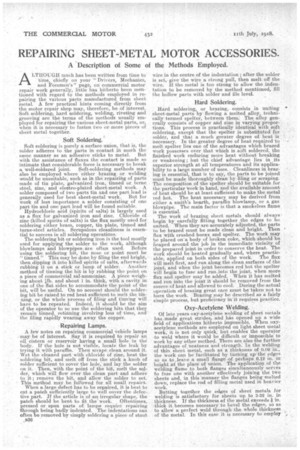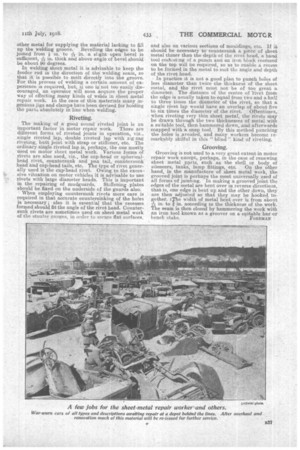REPAIRING SHEET-METAL MOTOR ACCESSORIES.
Page 14

Page 15

If you've noticed an error in this article please click here to report it so we can fix it.
. A Description of Some of
ALTHOUGH much has been written from time to ' tithe, chiefly on your " Drivers, Mechanics, and Foremen's" page, on commercial motor repair work generally, little has hitherto been mentioned with regard to the methods employed in repairing the various parts manufactured from sheet metal. A few practical hints coming directly from the motor repair shop may, therefore, be of interest. Soft.soldering, hard soldering, welding, riveting and grooving are the terms of the methods usually employed for repairing the various sheet-metal parts, or, when it is necessary to fasten two or more pieces of sheet metal together.
Soft Soldering.' Soft soldering is purely a surface union, that is, the solder adheres to the parts in contact in much the same manner as an adhesive sticks to metal. But with the assistance of fluxes the contact is made so intimate that considerable force is necessary to break a 'well-soldered joint. Soft-soldering methods may also be employed where either brazing or welding would be unsuitable, such as in the repairing of parts made of tin plate, galvanized iron, tinned or tome steel, zinc, and eleetro-plated sheet-metal work. A solder composed of two parts tin and one part lead is generally used for best sheet-metal work. But for work of less importance a solder consisting of one part tin and one part lead will be found suitable. Hydrochloric acid (spirits of salts) is largely used as a flux for galvanized iron and zinc. Chloride of zinc (killed spirits of salts) is the flux mostly used for soldering either brass, copper, tin plate, tinned and terne-steel .articles. Scrupulous cleanliness is essential to success in all soldering operations. The soldering bit or soldering iron is the tool mostly used for applying the solder to the work, although blowlamps and blowpipes are often used. Before using the, soldering bit, the nose or point must be "tinned." This may be done by filing the end bright, then dipping it into killed spirits of salts, afterwards rubbink it on a stick or lump of solder. Another method of tinning the bit-is by rubbing the point on a piece of commercial_sahammoniac. A piece weighing about 11.b. and about 1 in. thick, with a cavity in one of the flat sides to accommodate the point of the bit, will be useful. On no account should the soldering bit be raised tored heat sufficient to melt the tinning, or the whole process of filing and tinning will have to be repeated. Indeed, it should be the aim of the operator to so use the soldering bits that they remain tinned, retinning involving loss oftime, and the filing rapidly wearing away the copper. .
-Repairing Lamps. A few notes on repairing commercial vehicle lamps may be of interest. Say it is required to repair an oil cistern or reservoir having a small hole in the body.. If the hole is not visible, locate the leak by trying it with paraffin_ Then scrape clean around it. Wet the cleaned part' with chloride of zinc, heat the soldering bite and melt, off from the stick a knob of solder sufficient to cover the hole; -and lay the solder on it. Then, with the point of the bit, melt the solder, which will flow over the clean partand adhere to it; remove the bit, and allow the solder to set. This method may be followed for all small repairs. When a large defect has to be repaired, it is best to cut a patch sufficiently large to well cover the defec-, five part. If the article is of an irregular shape, the patch should be bent to fit the work. Oftentimes, pressed or spun parts of lamps require repairing through being badly indented. The indentations can often be removed by simply soldering a piece of stout B36
the Methods Employed.
wire in the centre of the indentation • after the solder is set, give the wire a strong pull, then melt off the wire. If the metal is too strong to allow the indentation to be removed by the method mentioned, fill the hollow parts with solder and file level.
Hard Soldering.
Hard soldering, or brazing, consists in uniting sheet-metal parts by flowing a melted alloy termed spelter, between them. The alloy 'gen erally consists Of copper and zinc in varying proportions. This process is practically identical with soft soldering, except that the spelter is substituted for solder, and that a much greater degree of beat is necessary. In the greater degree of heat required to melt spelter lies one of the advantages which brazed work possesses over that which is soft soldered, the finished work enduring more 'heat withoutbreaking or weakening; but the chief advantage lies in its superior strength at all temperatures and its applicability to a large number 6f uses. Cleanliness in -brazing is essential, that is to say; the Parts to be joined must be made thoroughly clean by filing or scra,ping. The composition of the spelter should be suitable for the particular work in hand,. and the available amount of heat should be at least sufficient to make the metal red -hot. The heat necessary, may be derived from either a smith's hearth, paraffin blowlamp, or a gas blowpipe. The main factor is that a smokeless flame is essential. • begin by carefully fitting together the edges to be united. When they are accurately adjusted, the parts to be brazed must be made clean and bright. Then flux with crushed borax and spelter. The work may be placed on a body of breken coke, which should be heaped around the lob in the immediate vicinity of the prepared joint in order to conserve the heat. The work should be heated gradually and, where practicable, applied on both sides of the work. The flux will melt first,' and run along the clean surfaces of the joint, and when the joint becomes red hot the spelter will begin to fuse and run into the joint, when more flux and speller may be added. When it has melted and run into, the joint it should be removed. from the source of heat and allowed to cool. During the actual operation of brazing great care must be-taken not to burn the work. Brazing may be described as a fairly simPle process, but proficiency in' it requires practice. The work of brazing. sheet metals should always
Oxy-Acetylene Welding.
Of late years oxy-acetylene welding of sheet metals has made great strides, and has opened up a wide field of applications hitherto impossible. When oxyacetylene methods are employed on light sheet metal work, it is not only quick, but enables the operator to weld where it would be difficult or impossible to work by any other method. There are also the further advantages of, neatness and strength: In the welding of thin sheet metal, such as a thickness of 0.02 in., the work can be facilitated by turning up the edges so as to, leave a small flange of perhaps 0.12 in. inheight at the place of union. The applicatiOp of the welding flame to both flanges simultaneously serves to fuse one with another effectively joining the two sheets and, in this "manner the flanges being-melted down, replace the rod of filling metal used in heavier work. Butting together the edges of sheet metals for welding is satisfactory feu. sheets up to 3-32 in. in thickness. If the thickness of the metal exceeds thick it becomes necessary to bevel the edges, so as to allow a. perfect weld through the. whole. thickness of the Metal. In this case it is necessary to employ
other metal for supplying the material lacking to fill up the welding groove. Bevelling the edges to be
joined from in, toin. a slight open bevel is sufficient, A in. thick and above angle of bevel should be about 90 degrees. In welding sheet metal it is advisable to keep the feeder rod in the direction of the welding seam, so that it is possible to melt directly into the groove. For this process of welding a certain .amount of experience is required, but, f one is not too easily.dis-couraged, an operator will soon acquire the proper way of effecting many kinds of welds in sheet metal repair work. In the case of thin materials many ingenious jigs and clamps have 'been devised for holding the parts absolutely in line when welding.
Riveting.
The making of . a good sound riveted joint is an important factor in motor repair work. There are different forms of riveted joints in operation, viz., single riveted lap; double riveted lap with zig-zag riveting, butt joint with strap or stiffener, etc. The ordinary single riveted lap is, perhaps, the one mostly used on motor sheet metal work. Various forms of rivets are also used, viz., the Cup-head or sphericalhead rivet, countersunk and_pa,n tail, countersunk head and cup-head tails, etc. The type of rivet generally used is the cup:head rivet. Owing to the exe.essive vibration on motor vehicles it is advisable to use rivets with large diameter heads. This is important in the repairing of mudguards. Stiffening plates should be fixed on the underside of the guards also: When employing countersunk rivets more care is required in that accurate countersinking of the holes is necessary ; also it is .essential that the recesses formed should fit the angle of the rivet head. Countersunk rivets are sometimes used on sheet metal work of the stouter gauges, in order to secure flat surfaces. and also on various sections of mouldings, eta. If it should be necessary to countersink a piece of sheet metal thiner than the depth of the rivet head, a hand tool coausting of a punch and an iron block recessed on the top will be required, so as to enable a recess to be formed in the metal to suit the angle and depth of the rivet head.
In practice it is not a good plan to punch holes of less diameter than twice the thicknesS of the sheet Metal, and the rivet must not be of too great a diameter. The distance of the centre of 'rivet from the edge is usually taken to equal from two and a half to three times the diameter of the rivet, so that a single rivet lap would have an overlap of about five to six times the diameter of the rivet. Oftentimes, when riveting very thin sheet metal, the rivets may be drawn through the two thicknesses of metal with a suitable tool, then hammered down, and afterwards snapped with a snap tool. By this method punching the holes is avoided, and rnan3r workers become ieroarkably skilful in this "blind" kind of riveting.
Grooving.
Grooving is not used to a very great extent in motor repair work except, perhaps, in the case of renewing sheet metal pzirts, such as the shell or body of . silencers, tanks, lamp fittings, etc. On the other hand, in the manufacture of sheet metal work, the grooved joint is perhaps the most universally used of all forms of jointing. In making a grooved joint the edges of the metal are bent over in reverse directions, that is, one edge is bent up and the other down, they are then adjusted so that they may be hooked. together. he width of metal bent over is from about in. to #n. according to the thickness of the work. The seam is then closed by hammering the work with an iron tool known as a groover on a suitable bar or bench stake. FOREMAN






















